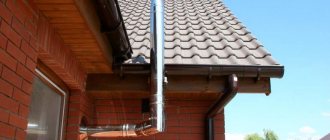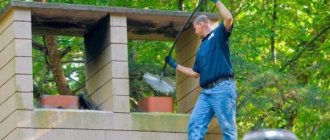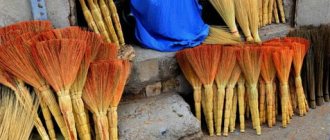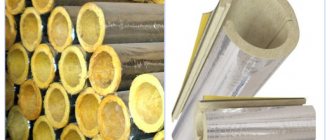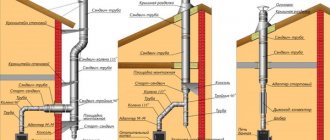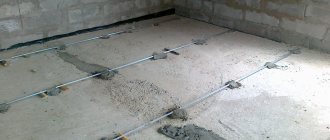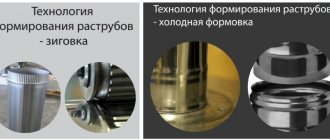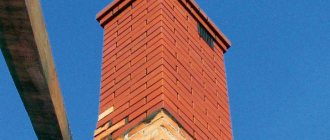- Soot formation
- Method one: cleaning with a brush
- Mechanical method
- Prevention
Often, when the oven is used incorrectly, clogging occurs, which precludes its further use for its intended purpose. Before you clean the pipe in the bathhouse, you should understand the causes of the problem. There are many effective cleaning methods, the choice of each of them depends on the desire of the owner and his financial capabilities.
Checking the technical condition of smoke ducts
First of all, you should definitely make sure that the pipeline is in good condition and intact. When it works intermittently, it is important to determine the reason for its incorrect functioning. The following steps are shown for this:
- visual inspection;
- use of special video systems;
- study of indirect signs that may indicate blockage.
Visual inspection
This is the simplest technique that does not require professional skills. It is enough to disassemble the pipeline and inspect the parts from the inside. If design features do not allow you to remove individual elements, you must take any lighting fixture and lower it into the stove from the roof or through special inspection holes (when provided). If there is a large amount of soot deposits, it will be noticeable even to a layman.
Special video systems
How and with what to clean the chimney pipe in a bathhouse from soot if you don’t want to dismantle the structure, climb onto the roof of the building and contaminate your clothes? You can call specialists with a video system to your home. This option is especially welcome if the stove is complex and has some defective areas. Procedure:
- the device is connected to the PC;
- a chamber with a light element is placed in the oven;
- specialists examine the surface from the inside along its entire length to identify blockages;
- Video recording is carried out, the file is subsequently reviewed, after which the information received is analyzed.
This method is expensive. However, it is important to remember that it is he who will allow us to assess the scale of the problem with one hundred percent probability.
Indirect signs
You can use them as a guide when diagnosing furnace problems:
- decrease in work efficiency - prolonged combustion of firewood;
- smoke entering the house through cracks;
- poor traction;
- presence of black smoke and soot flakes in the air;
- bad smell when lighting wood;
- sudden extinguishing of fire.
Slow kindling
Due to difficult ventilation, smoke quickly fills the entire volume of the chamber, so the firewood burns much more slowly than before. You should hurry to solve the problem, since this sign indicates that the furnace will soon fail.
Smoke comes in
If a smoke smell begins to enter the room through the damper, it is important to stop ignition and clean the stove as soon as possible. It is completely clogged and can no longer function.
Poor traction
You should definitely pay attention to the color of the flame. If all is well, it is bright and shoots upward. Otherwise, it fades and fluctuates in different directions. The draft can be checked using a lit match - bring it to the firebox and follow the flame (it should deviate inward).
Black smoke
It may indicate more than just blockage. Perhaps low-quality firewood was selected, and the solution to the problem will be to select a different fuel.
Soot flakes
The pipe is often clogged if soot flakes fly in the room where the stove is heating. If this problem is not solved in a timely manner, the chimney will become very clogged, and correcting the situation will require a lot of time and enormous labor costs.
Arbitrary flame extinction
Sometimes the fire can go out suddenly. If there is little or no draft, there is not enough oxygen in the firebox. It is strictly not recommended to leave the stove in this condition.
Unpleasant odor during heating
This is what carbon monoxide smells like when it is not being released due to a blockage. This situation requires immediate ventilation and stopping the heating of wood.
How to track a clog
It is important to detect a clogged chimney in a timely manner.
The main features are:
- dry fuel flares up with great difficulty or does not flare up at all;
- smoke persistently enters the room;
- the flame goes out quickly;
- presence of a pungent odor, tingling of the eyes.
An indirect sign will be the color of the flame. With normal draft, the fire is bright, plays with blue, orange, and red hues. When clogged, the flame is dim, often yellow-white.
The blockage is also noticeable upon visual inspection - the opening becomes narrow, carbon deposits, soot, and debris are visible on the walls.
Metal chimneys, their operation and care
Such structures can be single-walled and insulated. The material is resistant to temperature changes, changes in atmospheric pressure, prevents the accumulation of condensation and maintains performance characteristics for a long time. The advantages also include:
- high level of security;
- ease of maintenance;
- durability.
Modern models, which can be found in the Ferrum catalog, are more advanced. They have a special internal enamel coating that protects against rapid clogging. However, all the advantages do not relieve the owners from the obligation to clean it regularly.
About chimney pipe prevention
In the process of development, heating systems became more and more advanced. Some techniques have been experimentally developed to significantly reduce soot formation, such as:
- Chimney insulation. This is done in the following ways: by plastering the surface of brick pipes; covering the outer surface with various roll or slab insulation, followed by installing protection from foil film, metal sheet and other materials; the use of special insulated blocks with ceramic pipes for the installation of a chimney; protective devices to cover the chimney outlet from debris and bird nesting; the use of two-layer “sandwich pipes” made of metal with a layer of insulation.
The purpose of all these measures is to create conditions for rapid heating of the smoke channel, as a result of which the dew point in the process rises higher, until it exits into the environment.
- The largest amount of soot is formed at the bends of the chimney, so no more than one elbow should be used in the design if it is absolutely necessary to change its direction.
- When installing a chimney, it is mandatory to scrape the inner surface in order to reduce the number of irregularities that contribute to the deposition of soot.
- The use of chemical or biological methods for cleaning the internal surface of chimneys during combustion.
Types of blockages and the need to clean the chimney in a bathhouse
If the oven is not used properly, it will clog. Some problems can be prevented in advance using a set of preventive measures, others are eliminated only when detected. What are the most common causes of clogs?
Soot formation
If the pipe in the attic has not been insulated, drops of moisture may be found on the surface. They absorb the products of wood combustion, after which soot is formed. Gradually, with use, this layer becomes thicker, and over time the stove becomes completely clogged.
Condensation accumulation
If damp wood was used during kindling, a lot of steam will be generated. It disrupts traction and promotes the rapid formation of soot deposits on the internal walls. For this reason, it is important to store wood in a warm, dry place with good ventilation.
Foreign objects getting inside
If the diameter of the smoke channels is large and there is no protective cap, there is a risk of foreign objects getting into it. At first, they do not affect the functioning of the chimney in any way, but over time, as they accumulate, the draft worsens and disappears.
Resin deposition
The type of wood used for kindling greatly influences the blockage. If coniferous wood is used, a lot of resin is produced during combustion; it sticks to the pipe from the inside. Under no circumstances should you burn plastic, plywood fragments, or chipboards. Plum, birch and other deciduous trees are the most suitable options.
Ash accumulation
Designs with many bends and transitions clog much faster than simple ones. If your house has a complex chimney with bent sections, it is recommended to install special hatches in places near the bends, through which it will be convenient to subsequently clean it, removing excess debris.
Video description
The effectiveness of chemical cleaning agents is quite high. You can verify this by watching the video:
It is important! Do not try to get rid of deposits in the chimney using firecrackers or medicinal ampoules, which explode in the firebox when exposed to fire. This is dangerous and can simply destroy the oven.
Mechanical method
Cleaning a chimney in a private house should be carried out in calm and dry weather in order to minimize the risk of falling from the roof and make your work easier. But even under these conditions, the use of insurance in the form of a rope attached to a belt and a ridge or other durable roof element is mandatory.
The main tool of a chimney sweep is a brush with stiff bristles, which is used to scrape off plaque from the inner walls of the smoke channel. It is important to understand that such plaque deposits more actively on rough surfaces, protrusions and even scratches. And if it is difficult to damage a brick channel with a metal brush, then it is better to use plastic bristles for cleaning metal pipes and sandwiches.
Brush with nylon bristles Source media2.24aul.ru
See also: Catalog of companies that specialize in the sale and service of stoves and fireplaces
Its diameter should be slightly larger than the internal diameter of the pipe. In the case of a square and rectangular chimney, you will need another small brush to clean corners that are inaccessible to the main tool.
In addition to these, you may need:
- scraper for removing solid coked deposits;
- core for weighting the brush or breaking through debris jams with a diameter of about 2/3 of the internal cross-section of the chimney. At the end of the brush there should be a loop for attaching the core;
- rope or wire to which the tool will be tied. Furnace service organizations use more modern and convenient flexible telescopic holders.
Stores sell ready-made sets of various configurations, including those with flexible holders Source static-eu.insales.ru
Not wanting to spend money on a rarely used tool, some homeowners use homemade devices, making a brush from pine or juniper branches and tying a water-filled brush to it plastic bottle. Another option is a one and a half liter plastic bottle, the walls of which are cut into strips of 1.5-2 cm. Then a wire is passed through its bottom and neck and attracted to each other, while the strips fold, forming rigid loops in a circle, which allow for fairly high-quality cleaning chimney.
Note! Using weights, dumbbells, hammers and other heavy objects instead of a round core can cause an irregularly shaped load with a displaced center of gravity to get stuck in the pipe.
Before starting work, close all openings in the room through which soot can fly out: cleaning doors, firebox door. The open hearth is covered with film, gluing it around the perimeter with tape.
First, the fireplace is cleared of ash and a container is placed inside for falling soot Source pechiexpert.ru
Methods for cleaning a chimney
There are many cleansing options. All methods can be divided into 3 large groups:
- mechanical;
- chemical;
- use of folk remedies.
The choice of one type or another depends on the financial capabilities and personal preferences of the owner of the building. They all have both advantages and disadvantages.
Mechanical method
For cleaning, you will need a brush whose diameter exceeds the dimensions of the furnace channels, a strong cable or flexible stick for convenient immersion of the brush, a weighting agent 2 times smaller than the width of the hole. This is the so-called work with a ruff.
Chemical method
How to clean a pipe in a bathhouse if it is clogged, but you don’t want to act mechanically? The chemical method is based on the process of burning certain compounds, leading to the elimination of blockages without damaging the material of the structure. There are many drugs and other agents that act in a similar way.
Kominichek
Used to prevent clogging. It operates on the principle of a catalytic effect - soot turns into carbon dioxide. Due to its properties, the drug eliminates the risk of deposits igniting.
Chimney sweep
If you regularly use the oven, it is recommended to use this preventative product at least 2 times a month. If you do not light the bath very often, you can use the Chimney Sweep once every 8-10 weeks.
Anti-carbon chemical composition
This is a special powder with a special composition that allows you to eliminate plaque located on the inner walls of the pipe. Average consumption: 200 g per 1 ton of firewood. However, these indicators may change up or down depending on the manufacturer.
Salt
If the stove is very clogged, this remedy will be ineffective. It is better to use it for preventive purposes. This method must be used at least once every 2 weeks, otherwise it will not bring results. Stages:
- light wood in the stove;
- throw a handful of table salt into the firebox;
- wait some time for a chemical reaction to occur that prevents the accumulation of soot.
Smoke box
The container contains a special composition. It is placed in the firebox during the process of lighting the wood. Over the course of 2-3 hours, the product acts on the blockage and removes it. The effect after using the box lasts up to 2 weeks, the next use is indicated after about 3 months. One of the main advantages is that “Smoke” does not smell.
Vortex
A wooden log has a mass of 750 g. With its help, you can remove all the deposits that have formed. It is necessary to place the log on the firewood during ignition and let it burn until the end.
POLESHKO-TE
Application procedure:
- light wood;
- place POLESHKO-TE there;
- maintain an interval of several hours;
- do not remove the resulting ash, since the product will be effective for another 1-2 uses of the oven.
SAGINET
Used for preventive purposes to prevent the formation of blockages. Advantages:
- removes soot;
- increases the heat transfer of firewood;
- increases cravings;
- valid for up to 2 weeks after use.
Why clean
The stoves in the baths are fired with wood or liquid fuel, the processing of which involves numerous oxidative reactions.
The smoke consists of particles of the fuel itself and carbon. In the normal course of things, they come into contact with oxygen, carbon dioxide is formed, all products rise up and are discharged out through the pipe.
Some processed products inevitably stick around the perimeter. The more prominent the surface, the greater the amount deposited on the walls. The pipe opening narrows and air begins to circulate with difficulty. When there is too little oxygen, carbon monoxide is formed instead of carbon dioxide. Together with soot they create a danger.
Contamination can lead to:
Fire in the chimney
Soot ignites at 253C. In this case, the temperature in the oven easily reaches 1200C. The precipitate ignites instantly, sometimes accompanied by a pop or explosion. The situation is especially dangerous for metal bends. Together with them, the entire room can catch fire. Brick, unlike metal, burns out much less often;
Poisoning
Obstructed air movement leads to smoke in the bathhouse and can result in carbon monoxide poisoning leading to death. At best, only the respiratory organs and eyes will suffer from the acrid smoke;
Premises pollution
Poor draft contributes to the settling of soot on objects and the collection of copious soot on the stove;
Poor warm-up
A bathhouse with a malfunctioning chimney does not heat up well because the air moves unevenly.
The more often the steam room is used, the faster such clogging can occur.
Recommendations for the operation of stoves and chimneys
A few points that are important to know so that the structure lasts a long time and does not become clogged:
- It is best to use hardwood for kindling;
- do not add firewood one log at a time;
- do not burn garbage in the firebox;
- fire frequently, but little by little, with small stacks of firewood, and a new stack should be placed in the firebox after the previous one has burned out at least halfway;
- the logs must be completely dry;
- do not completely load the firebox with logs;
- prepare properly for cleaning - select the appropriate tool, use protective accessories, follow the instructions provided by the manufacturer;
- Cleaning the chimney pipe in a bathhouse from soot will not be difficult if you follow safety rules and follow the procedure according to all the rules.
Prevention
To avoid having to disassemble the entire structure and spend money on cleaning, it is necessary to take preventive measures. It is enough to use one of the products monthly to prevent blockages and the accumulation of a thick soot layer.
What weather is best to do it?
All manipulations should be performed only in warm, dry weather. There should be no wind.
FAQ
Is it possible to carry out cleaning in the winter season?
Theoretically it is possible. In practice, it is better to carry out the procedure in dry, warm weather. The most successful time would be the autumn or spring season. In winter, cleaning is recommended only when absolutely necessary. The safest option in case of a slippery roof and ice in the pipe is dry cleaning.
It is not possible to buy a special cable. What can replace it?
You can make a brush from a synthetic broom or a chopped bottle. The resulting strips of plastic are tied with wire to a plumbing cable. The design is not the most rigid, but acceptable. A “carbrush” welded to a metal rod will work more efficiently.
Soot accumulates at the joints of the chimney in the area of turns. Why?
It is highly likely that the pipe seal is broken. The joints must be checked and thoroughly welded.
How to do prevention?
Use any of the cleaning methods once every six months if you rarely use the bath, once a quarter if you use it frequently. In public baths, monthly cleansing is preferred. A good preventative measure would be a moderate load of firewood. By periodically adding fuel in small portions, it will have time to burn out completely and no heavy deposits will accumulate.
Characteristics of firewood
It is not always appropriate to compare heating a house with a stove and electricity or gas, since the stove additionally creates an atmosphere of comfort and unique family coziness. How pleasant it is to hear the soft crackling of firewood in the hearth in the silence of the doom, to feel the warmth emanating from it. Even in our time, these unique feelings are so pleasant to people that a high-quality stove or a good fireplace is built in almost every private home.
However, in order to effectively use the capabilities of the stove, you should understand firewood. It turns out that not all tree species are equally good for burning; there are many nuances that significantly complicate the choice of firewood for the stove.
For example, for burning in a fireplace, it is advisable to find wood that, when burned, emits a pleasant aroma, but does not emit a large amount of resin, soot, or soot. Resins in wood contribute to increased smoke output, as well as explosive cracking of logs with the release of large coals. Such emissions will be unsafe for an open fireplace, so coniferous wood is not used in them.
Firewood for the stove is selected based on heat transfer; its main criteria are the intensity and duration of combustion. It is desirable that the wood burns with less smoke and leaves behind a minimum of ash.
Wood for making fire
If we consider the optimal firewood for use in a stove, then it should have the following functionality:
- First of all, heat transfer is the maximum possible for wood.
- The flammability of the wood must also be excellent, so that lighting a fireplace is not difficult.
- When burned, firewood should not emit a lot of smoke and leave behind a small amount of ash.
To achieve such characteristics, it is important not only to choose the right type of wood, but also to properly dry the harvested timber and ensure its normal storage. Freshly cut wood is not used in kilns; to prepare it, it should be dried for some time, getting rid of excess moisture. Wet wood burns weakly and produces a large amount of smoke.
There is even a method for determining whether firewood is dry enough for use in fireplaces or stoves. You should hit one log against another and listen to the sound. If it is sonorous, then it is quite possible to use such logs for heating the hearth.
It is believed that the best firewood for fireplaces and stoves is obtained if logging is carried out in the winter. At this time, the trees are in a certain preserved state, as a result of which sap flow practically does not work in them. The worst thing is if the firewood is collected in the spring or summer, when the wood contains a large amount of moisture, such wood will dry out for a very long time.
Firewood harvested in winter can be split in summer
If we consider tree species, then it is best to choose deciduous options, since they have a fairly dense fiber structure. Such wood is capable of generating large amounts of heat for a long time. Most often, firewood is prepared from the following hardwoods: oak, birch, linden, alder, ash, aspen. Even fruit trees can be a good source of heat. In addition, the fragrant wood is perfect for use in a smokehouse or open fireplace.
Coniferous wood also burns well, but since they contain a large amount of resin, they emit a lot of smoke and soot when burning. The needles burn quite quickly, but produce mediocre heat, so for use in a stove at home it is better not to particularly consider this option, but to save the logs for the bath.
The stove asks me to wash myself, what should I do?
Removing smoke from the stove is a dubious pleasure. It is better to choose the fastest method: scrub off fresh fat, not frozen fat. It is enough to wipe the dirty stove with lemon, so as not to do this with ammonia. You can replace expensive fruit with citric acid.
Scraping off frozen plaque is a very labor-intensive task, especially if drops of grease have gotten between the glasses. In modern models, the inner glass of the door is removed. It's easy to clean and tidy up.
But glass baking trays are treated with ammonia if an unpleasant residue remains after washing without chemicals. A heavily contaminated surface requires a lot of effort.
Safety precautions
When cleaning a pipe from a roof, you should always remember the following safety precautions:
- You cannot work on the roof in rainy or windy weather;
- be sure to use insurance;
- in the absence of a safety system, you can tie a strong rope around your belt;
- Before work, it is prohibited to take any medications that may reduce the reaction rate. Drinking alcohol is strictly prohibited.
How to clean a chimney, video example:
Various animals can often live in a chimney pipe - birds like to make nests there, wasps build their honeycombs, etc. If it is possible to get a nest, then it is better to remove it through the top of the pipe. If it is deep, it is better to push it down
You should work with wasp nests carefully. If there is a colony of wasps living in it, then it is better to play it safe once again and wear a special beekeeper suit.
Folk remedies for combating soot accumulation
The most famous old-fashioned way of dealing with blockages in chimneys is burning potato peelings. Their use is most effective during intense combustion.
Under the influence of high temperature, steam with a high starch content is formed, which loosens and softens deposits. The soot flakes off and falls off. This method is suitable for preventing channel blockage and as preparation for mechanical cleaning.
Not only potato peelings are used to combat soot. They also use starch or rock salt, sprinkling them on firewood.
Burning aspen wood in large quantities as a method of cleaning soot from a chimney, although considered effective, can lead to bad consequences.
High temperatures, which lead to the ignition of soot in the chimney channels, can cause a fire if there are cracks or damage in it. In addition, not all metal sandwich chimneys can be operated at very high temperatures.
